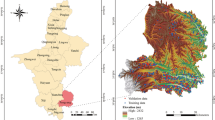Abstract
Rock proportion of subsoil directly influences the cost of embankment in forest road construction. Therefore, developing a reliable framework for rock ratio estimation prior to the road planning could lead to more light excavation and less cost operations. Prediction of rock proportion was subjected to statistical analyses using the application of Artificial Neural Network (ANN) in MATLAB and five link functions of ordinal logistic regression (OLR) according to the rock type and terrain slope properties. In addition to bed rock and slope maps, more than 100 sample data of rock proportion were collected, observed by geologists, from any available bed rock of every slope class. Four predictive models were developed for rock proportion, employing independent variables and applying both the selected probit link function of OLR and Layer Recurrent and Feed forward back propagation networks of Neural Networks. In ANN, different numbers of neurons are considered for the hidden layer(s). Goodness of the fit measures distinguished that ANN models produced better results than OLR with R 2 = 0.72 and Root Mean Square Error = 0.42. Furthermore, in order to show the applicability of the proposed approach, and to illustrate the variability of rock proportion resulted from the model application, the optimum models were applied to a mountainous forest in where forest road network had been constructed in the past.









Similar content being viewed by others
Notes
Specific cutting energy
References
Bieniawski, Z. T. (1973). Engineering classification of jointed rock masses. Transactions of the South African Institution of Civil Engineers, 15, 335–344.
Cox, D. R., & Snell, E. J. (1989). The analysis of binary data (2nd ed.). London: Chapman and Hall.
Deere, D. U. (1964). Technical description of cores for engineering purposes. Rock Mechanics and Engineering Geology, 1, 237–303.
Ghajar, I., Najafi, A., & Ezzati, S. (2010). Skidding machine allocation (SMA) using fuzzy set theory. Croatian Journal for Engineering, 31(2), 99–110.
Ghajar, I., Najafi, A., Torabi, S. A., Khamehchiyan, M., & Boston, K. (2012a). An adaptive network-based fuzzy inference system for rock share estimation in forest road construction. Croatian Journal of Forest Engineering, 33(2), 313–328.
Ghajar, I., Najafi, A., Torabi, S. A., & Boston, K. (2012b). Rock share estimation in forest road excavation using the Ordinal Logistic Regression (OLR) and the Analytical Hierarchy Process (AHP). Iranian Journal of Forest and Poplar Research, 20(2), 313–323 [In Persian].
Huang, R., Huang, J., Ju, N., & Li, Y. (2013). Automated tunnel rock classification using rock engineering systems. Engineering Geology, 156, 20–27.
Inaba, S., Heinimann, H.R., Shiba, M. (2001). A model to estimate rock excavation volume of forest roads in steep terrain conditions. In: Anonymous (Eds.): Proceedings of the112th Meeting of the Japanese Forestry Society. Japan, 2–4, April 2001.
Liu, Y. C., & Chen, C. S. (2007). A new approach for application of rock mass classification on rock slope stability assessment. Engineering Geology, 89, 129–143.
McFadden, D. (1974). Conditional logit analysis of qualitative choice behavior. In P. Zarembka (Ed.), Frontiers in economics. New York: Academic.
Metin, N. (2011). Determining of threat perceptions affecting direction of the US defense expenditures by using ordinal regression models. Quality and Quantity. doi:10.1007/s11135-011-9442-0.
Meulenkamp, F., & Alvarez Grima, M. (1999). Application of neural networks for the prediction of the unconfined compressive strength (UCS) from Equotip hardness. International Journal of Rock Mechanics and Mining Sciences, 36, 29–39.
Nagelkerke, N. J. D. (1991). A note on the general definition of the coefficient of determination. Biometrika, 78(3), 691–692.
Pulkstenis, E., & Robinson, T. J. (2002). Two goodness-of-fit tests for logistic regression models with continuous covariates. Statistics in Medicine, 21, 79–93.
Ramamurthy, T. (2004). A geo-engineering classification for rocks and rock masses. International Journal of Rock Mechanics & Mining Sciences, 41, 89–101.
Rostami, J., Ozdemir, L., Neil, D.M. (1994). Performance prediction: a key issue in mechanical hard rock mining. Mining Engineering, 1263–1267.
Seibi, A., & Al-Alawi, S. M. (1997). Prediction of fracture toughness using artificial neural networks (ANNs). Engineering Fracture Mechanics, 56, 311–319.
Singh, V. K., Singh, D., & Singh, T. N. (2001). Prediction of strength properties of some schistose rocks from petrographic properties using artificial neural networks. International Journal of Rock Mechanics and Mining Sciences, 38, 269–284.
Stuckelberger, J. A., Heinimann, H. R., & Burlet, E. C. (2006). Modeling spatial variability in the life-cycle costs of low-volume forest roads. European Journal of Forest Research, 125(4), 377–390.
Tiryaki, B. (2008a). Predicting intact rock strength for mechanical excavation using multivariate statistics, artificial neural networks, and regression trees. Engineering Geology, 99, 51–60.
Tiryaki, B. (2008b). Application of artificial neural networks for predicting the cut ability of rocks by drag tools. Tunneling and Underground Space Technology, 23, 273–280.
Wang, X., & Dey, D. K. (2010). Generalized extreme value regression for ordinal response data. Environmental and Ecological Statistics. doi:10.1007/s10651-010-0154-8.
Wickham, G.E., Tiedemann, H., Skinner, E.H. (1972). Support determination based on geologic predictions. Proc. 1st Rapid Exc. Tun. Conf. AIME, New York, pp. 43–64.
Acknowledgments
The authors would like to express their appreciation to Ellen Vuosalo Tavakoli (University of Mazandaran) for final editing of the text.
Author information
Authors and Affiliations
Corresponding author
Rights and permissions
About this article
Cite this article
Babapour, R., Naghdi, R., Ghajar, I. et al. Modeling the proportion of cut slopes rock on forest roads using artificial neural network and ordinal linear regression. Environ Monit Assess 187, 446 (2015). https://doi.org/10.1007/s10661-015-4688-y
Received:
Accepted:
Published:
DOI: https://doi.org/10.1007/s10661-015-4688-y




